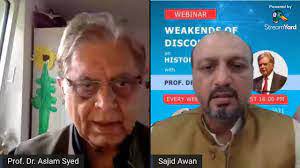ISLAMABAD, (Parliament Times) : Delhi Sultanate, consisting of five dynasties, founded after the Turkish invasion ruled India with almost the same style of governance, said Prof Aslam Syed in the Discourse of History on Indo-Pak History from Antiquity to Modernity VII: Muslim Rule in India here.
He said Delhi Sultanate, collectively consisted of Slave/Mamluk Dynasty (1206AD-1290AD), Khilji Dynasty (1290AD-1320AD), Tughlaq Dynasty (1320AD-1412AD), Sayyid Dynasty (1414AD-1451AD) and Lodhi Dynasty (1451AD-1526 AD).
The guest speaker Prof. Emeritus Aslam Syed has been serving the Center for Religious Studies, Ruhr Universität, Bochum, Germany. He remained Chairman, Department of History, Quaid-i-Azam University, Islamabad and also served the NIHCR as its Director.
Responding to a question, Prof Syed said that the establishment of the Delhi Sultanate began with the invasion of Muhammad Ghauri. He had brought a large number of slaves and appointed them as officers. Ghauri appointed Qutubddin Aibak as ruler of India who founded the dynasty of slave sultans. He justified his selection and confidence placed in him by extending his territory from Delhi to Bengal, he said.
The Webinar, arranged online by the National Institute of Historical and Cultural Research (NIHCR), Centre of Excellence, Quaid-i-Azam University, Islamabad, was attended by over 800 participants ranging from students, teachers and researchers to have greater insights into the valuable views of the guest speaker.
Replying a question, Prof Syed said that the slave dynasty was followed by another Turk dynasty of Khiljis who ruled India from 1290 to 1320. The most prominent of the Khiljis ruler was Alauddin who ruled India for 20 years. It was Bakhtiyar Khilji who brought Bihar and Bengal under control. It is said Khiljis saved India and Hinduism from Mongols, as they defeated Mongols several times successfully, he said.
It was the 26th consecutive session on the Discourse of History, a brainchild of the NIHCR Director Dr Sajid Mahmood Awan. This activity inculcates interest to learn more and more about history not only among students, scholars and historians as well as among ordinary people belonging to any field of life to know about nations’ ways of running their States in a journey from antiquity to modernity.
To a question, Prof Syed said that the Khiljis were replaced by another Turkish dynasty the Tughluks, who ruled India for 70 years. In 1397, Taimur entered India; the immediate effect was that India divided into two parts—the northern half was under Muslims (Turks, Afghans, Sayyeds and Lodhis) and the south became independent under Hindus kings, Prof Syed said.
By the time, Prof Syed said, Babar of the Mughal dynasty came to India in 1526. In four years, Babar occupied whole of northern India. In between, from 1540 to 1545, Sher Shah Suri was the emperor of India. Later, Hamayoun regained Mughal dynastic rule by defeating Sher Shah Suri.
The NIHCR Director Dr Awan conducted the Webinar by triggering a dialogue with Dr Syed for substantiating this discourse. This inclusive activity has been taken up every week for the benefit of students in general and capacity-building of the teachers and researchers in particular, he said.

